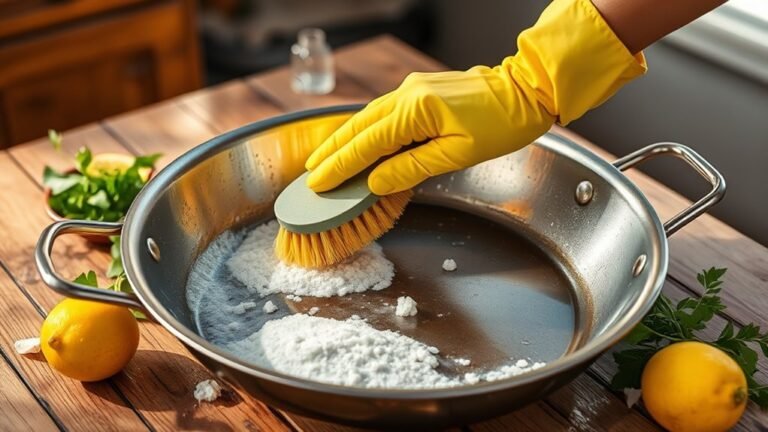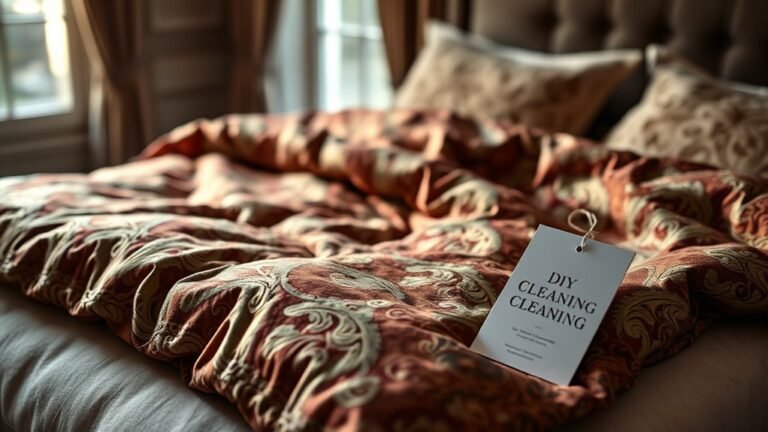Best Way to Sanitize Your Range Hood
To sanitize your range hood effectively, start by turning off power and removing the filters carefully. Soak metal filters in hot, soapy water or use the dishwasher, while replacing charcoal filters as needed. Use a degreaser and microfiber cloth to clean the hood’s exterior and interior surfaces, tackling grease buildup. Natural solutions like vinegar and baking soda work great too. Dry everything thoroughly before reassembling. Keeping a regular cleaning schedule will maintain performance and safety. There’s more to discover about making this routine even easier and safer.
Understanding the Importance of Cleaning Your Range Hood

Although you might not think about it often, keeping your range hood clean is crucial for maintaining a safe and efficient kitchen. When you prioritize range hood hygiene, you reduce grease buildup that can cause fires and poor ventilation. This simple habit protects your freedom to cook without worrying about hazards or foul odors. Neglecting this task can compromise kitchen safety by allowing smoke and harmful particles to linger, which affects your health and comfort. By staying on top of cleaning, you guarantee your kitchen stays fresh and functional, giving you peace of mind and control over your space. Remember, a clean range hood isn’t just about looks—it’s about creating a safer environment where you can enjoy your cooking adventures without limits.
Tools and Materials Needed for Sanitizing
Getting your range hood properly sanitized requires having the right tools and materials on hand. You’ll want to gather essential cleaning supplies like a degreaser, microfiber cloths, a soft brush, and a bucket of warm water. These items make tackling built-up grease and grime easier and more effective. For sanitizing methods, a mixture of vinegar and water or a mild disinfectant spray works well to kill bacteria without harsh chemicals. Don’t forget rubber gloves to protect your hands and a step stool if your hood is high up. Having everything ready before you start lets you move freely and efficiently through the job, ensuring your range hood is fresh and safe without hassle.
How to Safely Remove and Clean the Filters

The filters in your range hood play a crucial role in trapping grease and airborne particles, so removing and cleaning them properly is essential. First, identify your filter types—commonly mesh, baffle, or charcoal—since each requires a specific approach. Next, follow your cleaning frequency to keep performance ideal; generally, monthly for mesh and baffle filters, and every 3-6 months for charcoal ones.
Here’s how to safely remove and clean your filters:
- Turn off power and let the filters cool down completely to avoid burns.
- Gently unlatch or slide out filters according to the manufacturer’s instructions.
- Soak metal filters in hot, soapy water or run them in the dishwasher; replace charcoal filters as needed.
Stay consistent with this routine to maintain a fresh, efficient kitchen environment.
Cleaning the Exterior Surface of the Range Hood
When cleaning your range hood’s exterior, it’s important to pick safe cleaning products that won’t damage the finish. You’ll want to focus on removing grease and grime effectively without harsh scrubbing. Finally, polishing the surface helps protect it and keeps your kitchen looking sharp.
Choosing Safe Cleaning Products
Although you might be tempted to use any household cleaner, choosing safe cleaning products for your range hood’s exterior is essential to avoid damage and guarantee effective sanitation. You want products that respect both your health and the environment, letting you clean freely without worries. Consider these points:
- Opt for eco friendly options that minimize chemical exposure and environmental impact.
- Check labels for chemical safety, avoiding harsh acids or abrasives that can harm finishes.
- Use mild detergents or vinegar-based solutions to safely break down dirt while preserving surface integrity.
Removing Grease and Grime
Picking the right cleaning products sets you up for success in tackling grease and grime on your range hood’s exterior. Start with a degreaser that’s effective but gentle enough not to damage surfaces. Spray it evenly, let it sit briefly, then wipe with a microfiber cloth to lift away stubborn grease. For grime prevention, make it a habit to clean after cooking—this stops buildup before it hardens. Avoid abrasive tools that can scratch the finish, making grease removal harder next time. You want a routine that frees you from heavy scrubbing while keeping your kitchen fresh and inviting. By staying consistent, you maintain your range hood’s shine and function without hassle, freeing up your time for what really matters.
Polishing and Protecting Finish
Once you’ve removed the grease and grime, it’s essential to polish and protect your range hood’s exterior to keep it looking its best. You want to use effective polish techniques that restore shine without damaging the surface. Start by choosing a soft cloth to gently buff the hood, enhancing its natural finish. Next, apply a protective coating to shield against future dirt and fingerprints. Some options include:
- Microfiber cloths for scratch-free polishing
- Stainless steel polishes designed for kitchen appliances
- Clear protective sprays that repel grease and moisture
Dealing With Grease Buildup Inside the Hood
When grease builds up inside your range hood, it can reduce its efficiency and pose a fire hazard. To keep your kitchen safe and your hood working freely, you need to tackle grease accumulation regularly. Start by removing the filters and soaking them in hot, soapy water to loosen trapped grease. Scrub gently with a brush to avoid damage, then rinse and dry thoroughly. Don’t skip filter maintenance, as clean filters trap grease better and improve airflow. Next, wipe down the interior surfaces with a degreaser or a mix of warm water and dish soap. Be sure to reach all corners where grease tends to hide. Staying on top of this prevents buildup, keeps your range hood running smoothly, and guarantees your cooking space remains fresh and safe.
Natural Cleaning Solutions for Sanitizing

You can tackle sanitizing your range hood with natural solutions that are both effective and safe. Vinegar cuts through grease, baking soda scrubs away grime, and adding essential oils gives a fresh scent while boosting cleaning power. These simple ingredients make it easy to keep your kitchen fresh without harsh chemicals.
Vinegar Cleaning Benefits
Although many commercial cleaners promise powerful results, vinegar stands out as a natural and effective option for sanitizing your range hood. Its acidity tackles grease and grime while being safe and eco-friendly, making vinegar benefits hard to ignore. If you’re seeking freedom from harsh chemicals, vinegar is a straightforward choice that cleans thoroughly without residue. Plus, if you want vinegar alternatives, there are other natural options, but vinegar remains top-tier.
Here’s why vinegar is a smart pick:
- Cuts through stubborn grease and buildup effortlessly
- Kills bacteria without toxic fumes
- Leaves no harmful residue, ensuring a fresh, clean surface
Baking Soda Uses
A key ally in natural cleaning, baking soda offers a gentle but effective way to sanitize your range hood. Its alkaline nature breaks down grease and neutralizes odors, making it a staple in baking soda applications. Not only does it clean thoroughly, but it also avoids harsh chemicals, giving you the freedom to keep your kitchen safe and fresh. Here’s a quick look at some baking soda benefits and how you can use it:
| Baking Soda Benefits | Baking Soda Applications |
|---|---|
| Cuts grease and grime | Mix with water to scrub filters |
| Neutralizes odors | Sprinkle on surfaces before wiping |
| Non-toxic and eco-friendly | Create a paste for tough stains |
Using baking soda means you’re choosing a natural, effective solution to keep your range hood spotless.
Essential Oils Added
Building on the natural power of baking soda, adding essential oils can boost your range hood’s cleanliness while leaving a fresh scent behind. You’ll enjoy the essential oil benefits not just for their pleasant aroma but also for their natural antibacterial properties. Aromatic sanitizing means you’re cleaning effectively without harsh chemicals, giving you more freedom to maintain a healthy kitchen environment.
Try blending a few drops of these oils with your baking soda paste:
- Tea tree oil: Known for its strong antimicrobial effects.
- Lemon oil: Cuts through grease and adds a zesty freshness.
- Eucalyptus oil: Offers a clean, invigorating scent and natural disinfectant qualities.
Using essential oils this way transforms your sanitizing routine into a simple, natural, and effective process.
Using Commercial Cleaners Effectively
When you choose to use commercial cleaners for your range hood, knowing how to apply them correctly can make all the difference. To maximize commercial cleaner effectiveness, start by reading the label carefully—each product has specific instructions tailored to its formula. Spray or apply the cleaner evenly across greasy surfaces, ensuring full coverage without over-saturating. Let the cleaner sit for the recommended time to break down stubborn grime, but don’t let it dry out. Using proper application techniques, such as gentle scrubbing with a non-abrasive sponge, helps lift residue without damaging your hood. Rinse thoroughly with warm water to remove any cleaner remnants. By following these steps, you’ll enjoy a thoroughly sanitized range hood that feels fresh and looks great, giving you the freedom to cook without worry.
Drying and Reassembling Your Range Hood
Although cleaning is essential, drying your range hood thoroughly is just as important to prevent moisture buildup and potential damage. After washing, make certain every part is completely dry before reassembling to avoid mold or corrosion.
When you’re ready to put your range hood assembly back together, keep these tips in mind:
- Use a clean, dry cloth or let parts air dry in a well-ventilated space.
- Check the filter replacement schedule and install a fresh filter if needed.
- Align components carefully to guarantee proper fit and function.
Taking these steps gives you freedom from worries about lingering dampness or damage. A well-dried and correctly reassembled range hood will keep your kitchen fresh and your ventilation system running smoothly.
Tips for Regular Maintenance and Preventive Cleaning
Once your range hood is dry and reassembled, keeping it in top shape means sticking to a regular maintenance routine. Create a cleaning schedule that fits your lifestyle—whether weekly or biweekly—so grease and grime don’t build up and limit your freedom from constant scrubbing. Use a maintenance checklist to track tasks like wiping down surfaces, cleaning or replacing filters, and inspecting fan operation. Staying consistent with these quick steps prevents bigger problems and keeps your kitchen fresh. Remember, a little effort now saves you time later, giving you more freedom to enjoy cooking without worrying about your range hood’s performance. By committing to this simple routine, you’ll extend your range hood’s life and maintain a healthier, cleaner kitchen environment.
Frequently Asked Questions
How Often Should I Replace My Range Hood Filters?
You should keep an eye on your filter replacement frequency to guarantee your range hood works efficiently. Generally, it’s a good idea to replace or clean the filters every 3 to 6 months, depending on how often you cook. Regular range hood maintenance like this frees you from worrying about grease buildup and keeps your kitchen air fresh. Staying on top of it lets you enjoy a cleaner, hassle-free cooking space.
Can I Use a Dishwasher to Clean Range Hood Filters?
You can use a dishwasher to clean your range hood filters, but it depends on dishwasher safety and filter materials. Metal filters, like aluminum or stainless steel, usually handle dishwashers well, making cleaning easy and freeing up your time. However, charcoal or mesh filters might get damaged or lose effectiveness, so hand washing is better for those. Always check your filter’s care instructions to keep it in great shape without hassle.
Are There Any Health Risks From Not Cleaning the Range Hood?
Imagine your range hood is like a breathing lung for your kitchen. If you let grease buildup go unchecked, it’s like clogging those lungs, making it harder to breathe freely. Not cleaning your range hood can lead to respiratory issues because trapped grease and particles pollute the air. So, keeping it clean isn’t just about looks—it’s about protecting your health and keeping your kitchen air fresh and free.
What Type of Range Hoods Are Easiest to Clean?
If you’re looking for ease, stainless steel range hoods are your best bet—they resist stains and are simple to wipe down. Under cabinet models tend to be easier to access, so cleaning won’t feel like a chore. You’ll appreciate how quickly you can keep them spotless, giving you more freedom to enjoy your kitchen without worrying about complicated upkeep. Go for sleek, practical designs that match your lifestyle.
Can Scented Cleaners Affect Cooking Odors?
Imagine your kitchen as a lively theater where cooking odors play the lead role. When you use scented cleaners, it’s like introducing a new actor who may steal the spotlight, blending or even masking those original aromas. If you value freedom in your culinary space, you’ll want to be cautious—scented cleaners can alter the natural character of your cooking odors, sometimes overpowering them instead of letting them shine true and pure.






